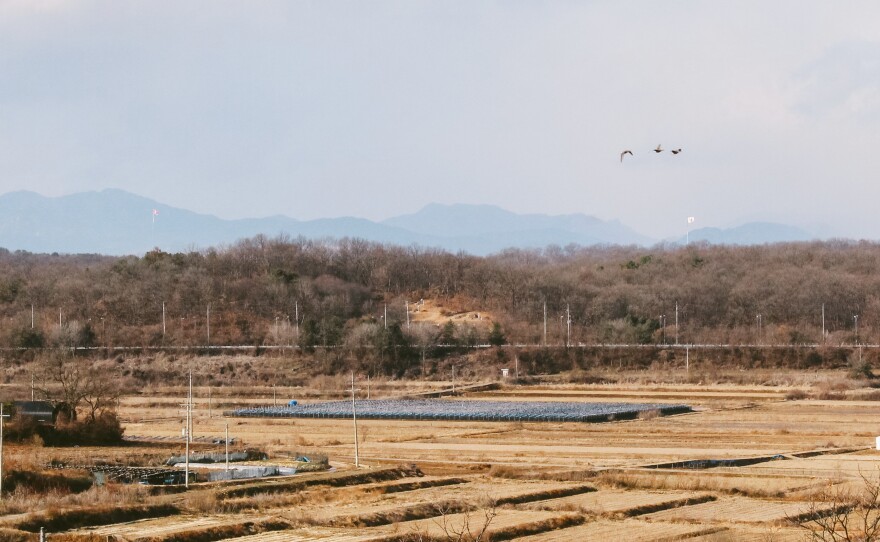This is the second part of a two-part series reported for KAZU by Oscar Jimenez, a Cal State Monterey Bay student who recently spent a semester studying political science and international relations at Kookmin University in Seoul, South Korea.
In South Korea, just a mile away from one of the most fortified borders in the word—the Demilitarized Zone between North and South Korea—lies a village unlike any other: Tongil Chon, the Unification Village. It is home to more than 400 people, mostly farmers, who try to live a peaceful, rural life in what is still officially a war zone.
Lee Jun-sub, a rice and pepper farmer, has lived in Tongil Chon for most of his life. He said the village is a reminder of the divide that continues to exist in Korea.
“In a way, our village is a barrier brought about by the great tragedy of our people that is the North-South division,” he said.

The village’s location, visible from North Korea, is no accident. Park Chung Hee, South Korea’s third president who seized power in a 1961 coup, established Tongil Chon in 1973. He saw it as a sign of national strength.
The South Korean government chose 40 civilian families and 40 military families to live in Tongil Chon. Most of the villagers were farmers willing to accept the dangerous border and the strict curfew in exchange for its fertile fields.
The curfew eventually became less strict, but the danger remains to this day, said apple farmer Myoung Seung-eui.

“During monsoon season, even on the asphalt roads landmines get swept down and explode,” he said.
But despite that, he said that Tongil Chon is just like any other village.
“Life here is just—flat. Peaceful,” he said. “Not overly fun or active and also not too loose, it is just that. It cannot be defined otherwise.”
Min Young-geun, a ginseng and soybean farmer, was born in Tongil Chon. His family was one of the village’s original civilian families. He, too, said that the threat has faded into the background of the peaceful life in the village.
“We have become numb to such things. They issue emergencies for everything so we just think: ‘Oh, another one,’” said Min. “We do not think about why, we just see that there is an emergency and think ‘There must have been another incident.’"

But that kind of complacency worries the head of the village's community center, Park Kyung-ho.
“Becoming dull is something which scares me,” Park said.
He pointed to the village’s large elderly population, which he fears might not be able to reach the village's bomb shelters in time in the event of an attack from the North.

But residents said the village’s unique situation, and the region’s long and painful history, never completely vanished. They note that when the Korean War ended, the peninsula was not only split in half, but it split a people. Thousands of families were separated without the possibility of ever seeing one another again. Min, the ginseng and soybean farmer, says it’s exactly what happened to his family.
“My mother's side of the family has their hometown up North, but we can't find anything now,” said Min. “My maternal uncle also tried to find information but had to give up. I suppose you can go, thinking of the old times and say ‘this was ours.’"
In the past, North and South Korea have worked together to hold brief reunions for separated families. However, around the time that diplomatic talks between the U.S. and North Korea failed in 2019, the reunions stopped.
But the villagers still hold out hope for a unified Korea.
“If me talking about reunification was enough to bring it about, then I would talk about it all day,” Park said.
Lee said that if there is anything to be learned from the long and often tumultuous history of the Korean Peninsula, it is patience.
“It took 1000 years for the old Korean Kingdoms to unify into one. It hasn’t been 100 years since we have been split, I think some more time has to pass.”
The villagers of Tongil Chon said that the contrast between their peaceful lives and the danger that is practically next door has never stopped Tongil Chon from thriving. The village will always be a reminder of their past, but also, as a beacon of hope for a bright, peaceful, unified future.



